ECGs, or electrocardiograms, help medical professionals read the electrical activity of a patient’s heart. ECGs are simple yet essential machines that allow nurses, nurse practitioners, doctors, and other healthcare professionals to quickly read a patient’s cardiac rhythm and identify other cardiac issues. In this article, we’ll take a look at what normal electrocardiogram intervals are and how to identify them on an ECG.
What Are ECG Intervals?
Before we get into what a normal ECG interval is, let’s first define ECG intervals. The heart’s muscles contract when responding to the electrical depolarization of muscle cells. When these muscles contract, the ECG records and summarizes the electrical activity as an “event” to reflect heart health and assist with diagnosis.
An ECG interval is the time between two specific ECG events. The most common intervals measured on an ECG are the PR interval, QRS interval, QT interval, The P-P interval, and the RR interval. Read on to learn more about identifying normal electrocardiogram intervals with examples.
What Intervals Are Included in an ECG?
ECG intervals show different measurements of the heart’s electrical activities. Most ECG machines will print ECG intervals on paper for easy EKG interpretation; however, not all healthcare professionals know how to interpret the various intervals. Understanding ECG measurements is an essential skill for medical professionals to have, especially when working with cardiac or critical care patients.
The ECG shows three different stages of the cardiac cycle. Medical professionals read these measurements on the ECG paper by counting the time in small squares, which is then converted to seconds. Each ECG interval measures different periods of cardiac activity.
P-R Interval
The P-R interval, sometimes referred to as the P-Q interval, begins at the P wave’s upslope and ends at the start of the QRS complex.
The P-R interval reflects the first part of the heartbeat. This interval encompasses depolarization of the sinoatrial (SA) node, the atria, and the atrioventricular AV node. The P-R interval may be longer than normal if the conduction is slowed in any of these areas. The P-R interval may be shorter than normal if conduction is enhanced in any of these areas. Lengthening or shortening usually indicates issues with the AV node.
P-P Interval
The P-P interval reveals the time between sinus beats. It is measured from the beginning of one P wave to the beginning of the next P wave. Usually, the sinoatrial (SA) node gives off impulses with a regular cadence. Sometimes the timing is irregular, as in sinus arrhythmia. This interval is short with sinus tachycardia, as might be seen during exercise. The interval is prolonged with sinus bradycardia, as may be seen while sleeping.
R-R Intervals
The R-R interval is the distance from one QRS complex to the next. Formally, it is from the beginning of one QRS complex to the next but is often just measured from the peak of an R wave to the peak of the next R wave for ease. The R-R interval is the same as the P-P interval in normal rhythms, and certain conduction abnormalities cause variations in the R-R interval.
QRS Interval
QRS complexes show the electrical activity from depolarization of the ventricles. The electrical impulse starts after the atrioventricular (AV) node and finishes once the entire lower heart muscles are stimulated. The QRS interval is measured from the beginning of the QRS complex to the end of the QRS complex. Usually, depolarization of the ventricles is quick, and the QRS complex is narrow. A wide QRS complex indicates a delay in impulse conduction.
QT Interval
The QT interval is the distance between the beginning of the QRS complex and the end of the T wave. Remember that the T wave represents ventricular repolarization or resetting of the electrical mechanism. The QT interval shows the time it takes for ventricular depolarization and repolarization.
Understanding the QT interval is critical for ECG interpretation as it shows ventricular activity in its entirety.

Start Your Membership Today
We make electrocardiogram interpretation simple and understandable. The videos are interactive, and have detailed, easy to follow illustrations.
Normal ECG Intervals
P-R interval
The P-R interval is measured from the beginning of the P wave to the beginning of the QRS complex. The P-R interval represents the time for depolarization of the sinoatrial (SA ) node, the atria, and the AV node. The normal P-R duration is 3-5 small boxes or 0.12 – 0.20 seconds.
QRS interval
The QRS interval is measured from the beginning of the QRS complex to the end of the QRS complex. The QRS interval represents depolarization of the ventricles. The normal QRS interval is 2-3 small boxes or 0.08 – 0.12 seconds.
QT interval
The QT interval is measured from the beginning of the QRS complex to the end of the T wave. This is not included in the measurement if a U wave is present. The QT interval always needs correcting for the heart rate. There are several formulas for correcting the QT interval, but the most common one used is Bazett’s formula. Using this formula, the corrected QT interval (QTc) is:
QTc = (measured QT) / √RR interval
The normal QTc is 0.35 – 0.44 seconds in men and 0.35 – 0.46 seconds in women.
Abnormal Intervals
Short PR Interval
Short PR intervals are under 0.12 seconds or less than three small boxes wide. The most common causes of a short PR interval include:
- Bypass tracts
- Accelerated atrioventricular (AV) node conduction
- Changes in sympathetic and parasympathetic tone
Although short PR intervals generally indicate a problem, they are not always a cause for concern. For example, athletes often have normal QRS complexes but short PR intervals, which is not unusual.
Not all patients with shortened PR intervals suffer from symptoms, which is why having the skill to interpret an ECG reading is vital.
Prolonged PR Interval
Prolonged PR intervals are often the result of delayed conduction at the AV node. A PR interval > 0.2 seconds is prolonged and generally referred to as a first-degree AV block. These are typically benign and do not require treatment. Prolonged PR intervals may be due to intrinsic disease of the AV node or due to medications. There are a few medical conditions, like hypothyroidism, that can cause delays of the PR interval.
Calculating Intervals
Time on the ECG is reflected on the X-axis, moving from left to right. A typical ECG is calibrated to 25 mm per second. This means that one small box’s width is 0.04 seconds. Five small boxes, the distance between thicker lines on the ECG, are 0.2 seconds, and the distance between 5 thicker lines is 1 second. Calculating the interval is simple and only involves counting the number of small boxes from left to right and then multiplying this by 0.04 seconds.
For example, suppose that the PR interval is measured as four small boxes across. When we multiply four by 0.04 seconds, we get 0.16 seconds. As noted earlier, the normal PR interval is 0.12-0.20 seconds long (3-5 small boxes). This PR interval, therefore, is normal.

Start Your Membership Today
We make electrocardiogram interpretation simple and understandable. The videos are interactive, and have detailed, easy to follow illustrations.
What’s the Difference Between Intervals and Segments?
Intervals refer to a period of time on an ECG, whereas a segment just represents a particular portion of the waves on the ECG. Intervals allow the medical provider to determine if conduction is hastened or delayed. Segments on the ECG are mainly used to determine other cardiac changes.
For example, the PR interval is the time for conduction through the SA node, the atria, and the AV node. Changes in the ST segment (the portion of the ECG from the end of the QRS complex to the beginning of the T wave) may indicate injury to the heart muscle.
Examples of Normal ECG Intervals
Every ECG interpretation course helps medical professionals identify normal electrocardiogram intervals with examples. Below are examples of normal ECG intervals that every healthcare professional should know:
- P-R interval (also known as the PQ interval): 0.12 to 0.20 seconds or three to five small squares
- QRS complex width: 0.08 to 0.20 seconds or two to three small squares
- Corrected Q-T interval: 0.35 to 0.45 seconds depending on the patient’s gender
Start Learning EKG Interpretation Today
Comprehensive knowledge of ECG interpretation can help healthcare professionals in various specialties provide better care for their patients and further their careers. From counting a heart’s beats per minute to analyzing the Q waves, Executive Electrocardiogram Education helps fellow medical professionals become experts in EKG interpretation.
Executive Electrocardiogram Education makes ECG interpretation understandable and straightforward. Our 8-hour video course is self-paced and designed to give a one-on-one feel to learning ECGs. The videos are interactive, have detailed, easy-to-follow illustrations, and have practice tests and quizzes. Sign up for our course now and learn our step-by-step approach to ECG interpretation.




